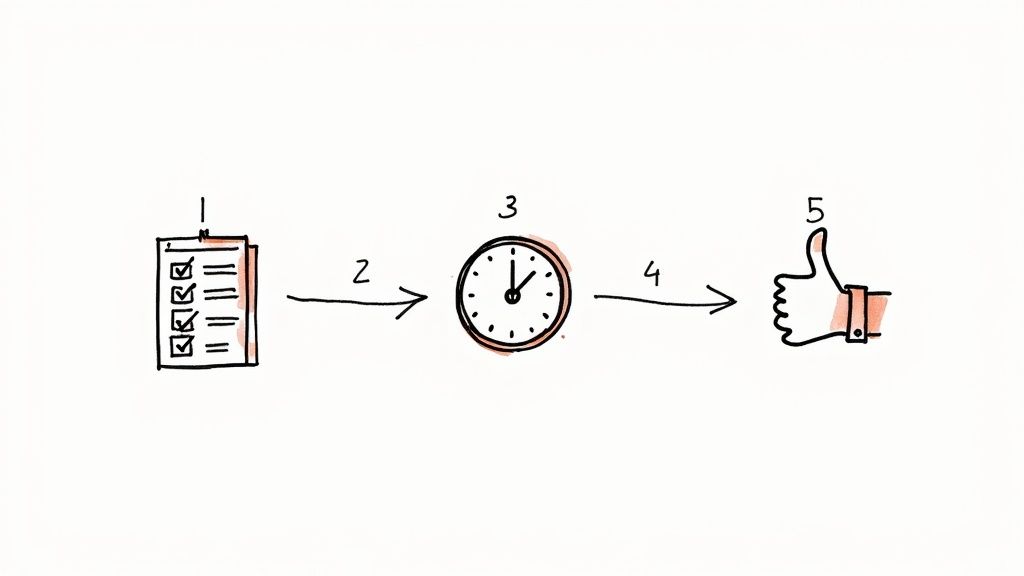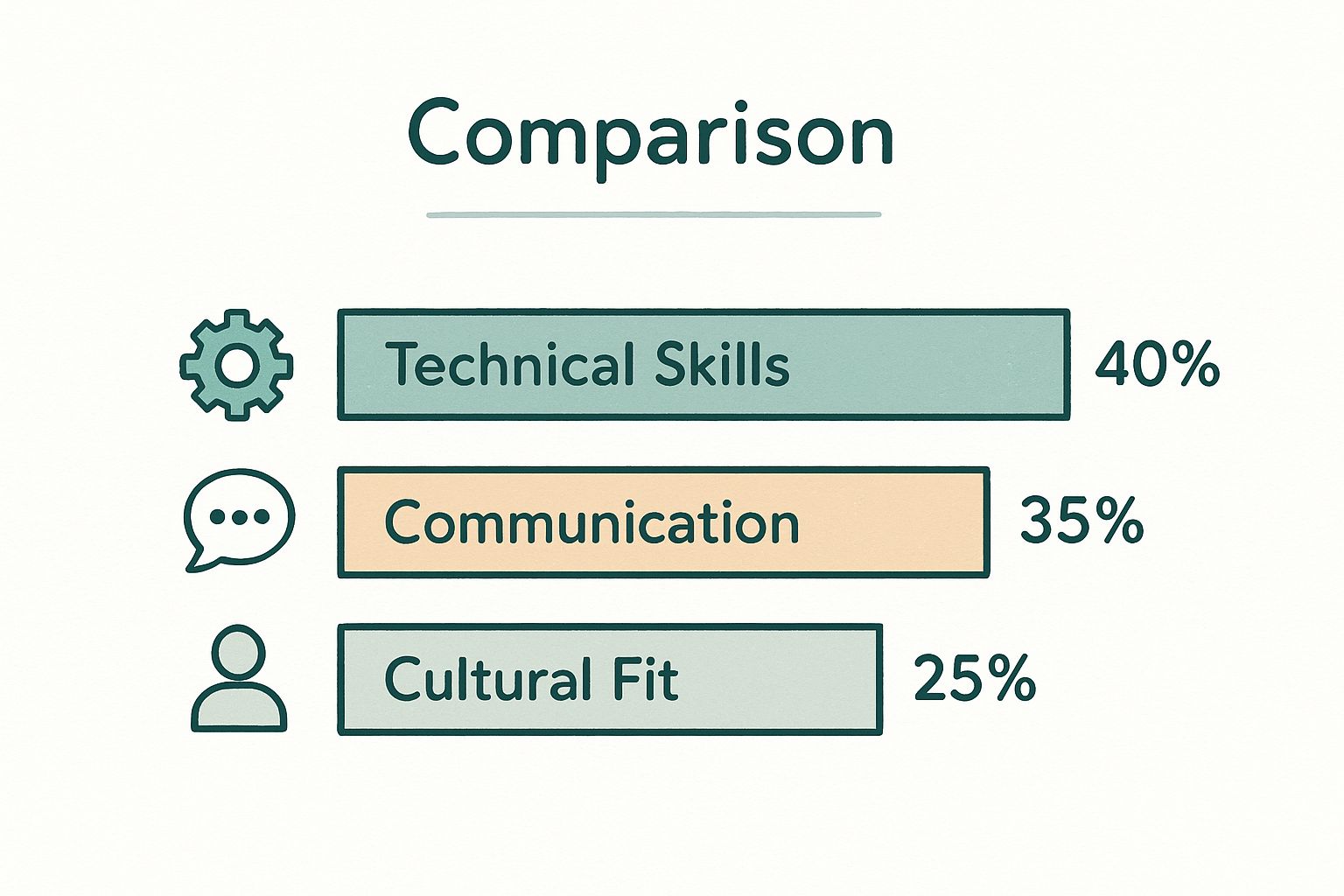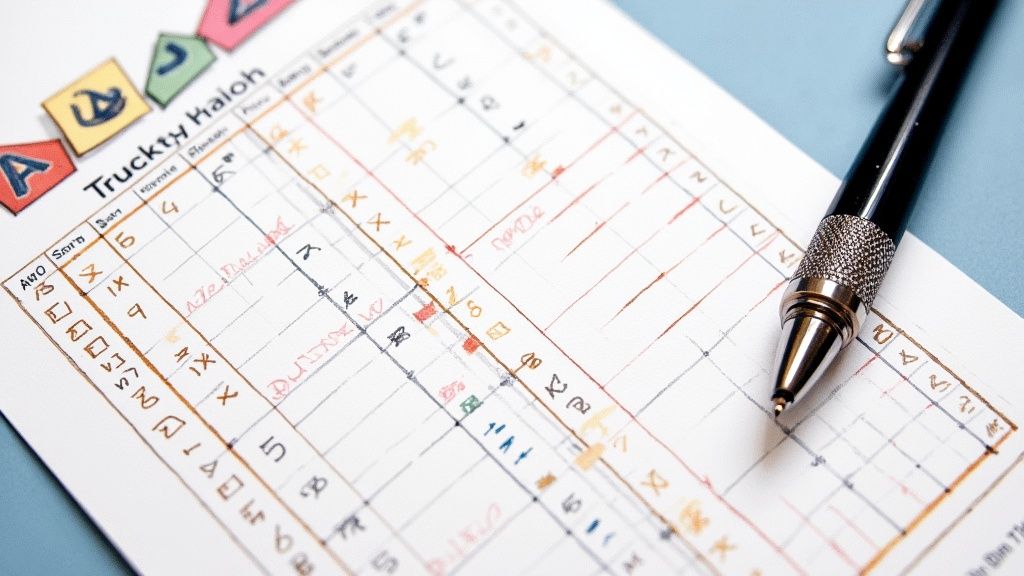So, what is an interview scoring sheet? It's your secret weapon. A structured form that forces your entire hiring team to evaluate candidates using the same yardstick. It’s the tool that yanks you out of the murky, biased waters of “gut feelings” and into the clear, objective world of data.
This isn't about making hiring robotic. It's about making it fair, smart, and a hell of a lot less painful.
The High Cost of a Bad Hire
Let’s be honest. We’ve all been there. We hired that person—the one who sailed through the interview with a magnetic personality and killer confidence, only to become a productivity black hole a few weeks later.
The $500 Hello, as I call it. The cost of that mistake isn’t just their salary. It’s the team morale they tanked, the projects they derailed, and the countless hours you and your managers wasted on damage control. Turns out there’s more than one way to make a hire without mortgaging your office ping-pong table.

We often blame these mistakes on a bad 'gut feeling,' but the real problem is that we relied on it in the first place. Gut feelings are notoriously unreliable, easily swayed by how much we like someone rather than how well they can actually do the job.
This is where a simple interview scoring sheet changes the game. It forces you to define what "good" actually looks like before a single candidate walks through the door.
It's the difference between navigating a road trip with a map versus just driving east and hoping for the best. Your scoring sheet is that map.
Stop Guessing, Start Scoring
Here's the hard truth: unstructured interviews are little better than a coin toss. One interviewer gets charmed by a shared love for a sports team, while another drills down on a niche technical question. You're left with a messy pile of subjective notes that are impossible to compare.
A bad hire isn't just a mistake; it's a debt. It's a mortgage on your team's future productivity, and you pay it off with lost time, energy, and momentum. A scoring sheet is your insurance policy.
This inconsistency is precisely how bad hires slip through. You end up comparing apples to oranges, making huge decisions based on vague impressions. The candidate with the best story often wins, not the one with the best skills for the job.
The Real Difference: Gut Feel vs. Data
Relying on instinct feels natural, but the data tells a different, much more expensive story. A structured approach isn’t just a nice-to-have; it’s a strategic advantage that protects your team from costly errors.
Gut Feel vs Structured Scoring: The Real Difference
| Hiring Approach | Evaluation Basis | Consistency | Bias Risk | Outcome |
|---|---|---|---|---|
| Gut Feel | Subjective rapport, charisma, personal connection | Wildly inconsistent between interviewers | Extremely High | High chance of a bad hire, low predictability |
| Structured Scoring | Predefined, role-specific criteria and competencies | Consistent across all candidates and interviewers | Significantly Reduced | High chance of a good hire, strong predictability |
The table makes it pretty clear. One path leads to guesswork and regret, while the other leads to clarity and confidence.
The Data Doesn't Lie
Don't just take my word for it. The evidence is overwhelming. Research consistently shows that using structured scoring sheets can boost the accuracy of your hiring decisions by a staggering 40%. Think about that. It's not a minor tweak; it's a fundamental improvement.
In fact, unstructured interviews only manage to cover about 9% of the factors that actually predict job success. A structured, scored approach, on the other hand, can hit nearly 100%. You can explore the research on interview scorecard effectiveness to see the numbers for yourself.
Using a scoring sheet ensures every candidate gets a fair shot. They face the same core questions and are measured against the same benchmarks. This simple shift accomplishes three critical things:
- It kills unconscious bias: The framework forces everyone to focus on skills and evidence, not just rapport.
- It creates alignment: Your entire hiring team operates from the same playbook, speaking the same language.
- It provides a paper trail: You have clear, defensible data to back up every hiring decision you make.
Ultimately, a scoring sheet is your guide to finding the right person, not just the right personality.
Building an Interview Scorecard That Actually Works
Alright, let's get down to brass tacks. You’re sold on the idea, but what magic ingredients go into a scoring sheet that isn't just a glorified checklist? A bad scorecard is just as useless as no scorecard at all.
I've seen scorecards that look like tax forms and scorecards so vague they might as well say, "Good vibes? Y/N." Both are recipes for disaster. The goal isn't to create more administrative work; it's to create clarity.
Define Non-Negotiable Competencies
First things first: define the non-negotiable, role-specific competencies. I’m not talking about fluffy HR buzzwords like "team player" or "synergistic mindset." Please, don’t do that.
I mean concrete, observable skills. For an engineering role, that might be:
- System Architecture: Can they design a scalable microservices backend?
- Problem-Solving: Can they debug a complex issue under pressure?
- Code Quality: Do they write clean, maintainable, and well-tested code?
For a marketing position, it could be:
- Copywriting: Can they write compelling B2B marketing copy that converts?
- Data Analysis: Can they interpret campaign data to find actionable insights?
- Strategic Planning: Can they outline a multi-channel launch strategy?
If you can't easily picture what a "good" answer looks like for a competency, it's too vague. Scrap it.
Create a Dead-Simple Rating Scale
Next, a clear and consistent rating scale. This is where most teams trip up. Whether you use a 1-5 scale or descriptive terms, the key is that everyone on the hiring team knows exactly what a '3' means.
Don't leave it to interpretation. Define your anchors clearly.
A rating scale without clear definitions is just an argument waiting to happen. It turns your objective scorecard into a subjective mess, defeating the entire purpose.
Here's an example I've used that works wonders:
- 1 – Unsatisfactory: Candidate could not answer or provided an incorrect/irrelevant answer.
- 2 – Needs Improvement: Showed basic understanding but missed key points or couldn't provide evidence.
- 3 – Meets Expectations: Gave a solid, complete answer with relevant examples. A solid hire.
- 4 – Exceeds Expectations: Went beyond the question, offering deep insights and proactive solutions.
- 5 – Exceptional: A "wow" answer that demonstrates mastery and strategic thinking. Truly top-tier.
Suddenly, a '3' isn't just a number; it's a shared definition of competence.
Demand Evidence Not Just Scores
This is the most important part. Your scorecard needs a section for evidence. I can't stress this enough. Don't just let an interviewer write down a "4"—make them write down why.
What did the candidate actually say that earned them that rating? This is your ultimate defense against fuzzy memory and unconscious bias. A few weeks later, when you’re comparing finalists, you won’t remember the specifics. Your notes will.
This turns a flimsy opinion into a defensible assessment. It grounds your debriefs in reality, not just vibes. For a deeper dive into structured candidate assessment, mastering the interview evaluation form offers additional perspectives.
Focus on Culture Contribution Not Fit
Finally, ditch the "culture fit" section. Seriously. It’s a lazy, dangerous metric that often becomes a proxy for "is this person exactly like us?" That’s how you build a homogenous echo chamber, not a high-performing team.
Instead, create a section for Culture Contribution. Ask a different question: "What unique perspective or skill does this person bring that we currently lack?" We're looking for people who add to our culture, challenge it, and make it stronger—not just replicate it. If you need inspiration, our guide to building an interview evaluation form template offers some great starting points.
How to Use a Scoring Sheet in a Real Interview
So you’ve built the perfect scoring sheet. It’s a masterpiece of clarity, a fortress against bias… you get the point. It’s a solid document. Now what?
Don’t you dare let it sit in a folder until after the interview. That defeats the entire purpose. A scoring sheet isn't homework; it's your co-pilot during the conversation. Using it in real-time is what turns it from a bureaucratic checkbox into a strategic tool.

It keeps you anchored to what actually matters for the job. It's that little voice stopping the interview from spiraling into a 45-minute chat about your favorite sports teams or the latest binge-worthy show.
Before the First Question
Preparation is everything. Don't glance at the scorecard two minutes before the call. That's a rookie move.
- Review the Scorecard: Actually read through every competency and the definition for each score. Ensure everyone knows what a "4" in "Problem-Solving" really looks like.
- Assign Questions: If multiple people are interviewing, figure out who’s asking what ahead of time. This avoids that awkward "who wants to go next?" shuffle and guarantees you cover your bases.
- Tell the Candidate: Start the interview with something simple: "Just so you know, I'll be taking some notes on a scorecard as we talk. It helps us stay focused and ensures we give every candidate a fair and consistent evaluation." Boom. You’ve just set expectations and come across as organized.
This prep work takes five minutes but pays off in a huge way.
During the Conversation
This is where the magic happens. Your job is to listen, probe, and score—all at once. It sounds like a lot, but the scorecard makes it easier.
You’re not just listening for an answer; you’re listening for evidence. The scoring sheet trains your brain to hunt for specific examples that prove or disprove a candidate's ability.
You don't need to write a novel. Just jot down key phrases or quotes that justify the score. Instead of "good answer," write: "Scored a 4—used STAR method to describe a conflict, took ownership of the mistake, and detailed the positive outcome."
That small note is the concrete evidence that will anchor the debrief. If you’re looking for more ways to steer these conversations effectively, check out our guide on how to conduct effective interviews.
The All-Important Debrief
Once the candidate signs off, the real work begins. Schedule a quick 15-minute debrief with the panel immediately after. Don't wait. Memory fades surprisingly fast.
This is where your beautifully crafted scoring sheet truly shines.
- Round-Robin Scoring: Go through the scorecard one competency at a time. Have each interviewer share their score and the evidence they wrote down. No hiding behind just a number.
- Challenge and Discuss: This is where one person’s "gut feeling" gets challenged by another's concrete evidence of a brilliant answer. The scorecard becomes the objective third party in the room, grounding the conversation in data, not vibes.
- Spot the Patterns: Is everyone aligned? If one person scored a candidate a '5' on communication and another scored them a '2,' that’s a red flag worth digging into. What did one person see that the other missed?
This structured process is the cornerstone of modern, effective hiring. It’s how you systematically remove bias and make defensible, data-backed decisions instead of just crossing your fingers.
Choosing The Right Scorecard Template For The Role
Let's get one thing straight: not all interview scoring sheets are created equal. You wouldn't use a sledgehammer to hang a picture frame, would you? Applying a one-size-fits-all scorecard to every role is just as clumsy.
Using the wrong template is like asking a fish to climb a tree and then scoring it poorly for failing. You have to match the tool to the task. The perfect scorecard for a senior developer will look completely different from one for a customer service rep, and that’s how it should be.
The Heavy-Hitter: The Weighted Criteria Sheet
For highly technical or leadership roles, the Weighted Criteria sheet is pure gold. This isn't your standard 1-to-5 scale across the board. It's a strategic approach where you decide upfront what really matters.
Think about hiring a Lead Engineer. Sure, communication skills are important, but their ability to architect a scalable system is non-negotiable. With a weighted scorecard, you can assign "System Design" a weight of 40%, while "Client Communication" might only be 10%.
This forces your panel to prioritize what's mission-critical. It prevents a candidate with dazzling charisma but mediocre technical chops from getting an inflated score. It’s the best way to align your evaluation with the job's actual demands.

This breakdown makes it clear that while technical ability leads, soft skills like communication are nearly as critical for success.
The Gatekeeper: The Pass/Fail Sheet
Now, let's talk volume. When you're sifting through hundreds of applicants for a compliance-heavy or entry-level position, efficiency is the name of the game. Enter the Pass/Fail Binary Assessment.
This template is brutally efficient. It’s a checklist of absolute must-haves. Does the candidate have the required certification? Pass/Fail. Can they work the required shift hours? Pass/Fail. Do they meet the baseline security clearance? Pass/Fail.
There’s no room for nuance here, and that’s the point. It’s a gatekeeper, designed to quickly screen out candidates who don’t meet foundational requirements. It's not for final-round decisions, but it’s a lifesaver for initial screenings.
The Founder's Favorite: The Behavioral Rating Scale
This is my personal favorite for most roles. The Behavioral Rating Scale is the ultimate weapon against vague feedback. It replaces a generic "1-5" scale with concrete, behavioral anchors.
This leaves almost no room for bias. Instead of guessing what a "3" in "Teamwork" means, the scorecard defines it for you.
A vague rating scale is an invitation for bias. Anchored descriptions turn a subjective opinion into an objective observation, which is the entire point of using scoring sheets for interviews.
Here’s what that looks like for "Problem-Solving":
- 1 – Provided a generic, textbook answer with no personal example.
- 3 – Described a relevant problem but the solution was unclear or ineffective.
- 5 – Clearly detailed a complex situation using the STAR method, showing a logical process and a positive, measurable outcome.
See the difference? It’s impossible to confuse a "1" with a "5." This forces interviewers to justify their scores with evidence, leading to much richer debriefs. For a selection of pre-designed formats, explore resources like these 12 Best Interview Evaluation Forms Templates.
Choosing the right format can feel overwhelming, but it boils down to matching the scorecard's strengths to the role's needs.
Which Scoring Sheet Template Is Right for You?
| Template Type | Best For | Key Advantage | Potential Downside |
|---|---|---|---|
| Weighted Criteria | Technical, leadership, or specialized roles where some skills are mission-critical. | Forces prioritization and aligns scoring with the job's true demands. | Can be complex to set up; requires upfront consensus on weights. |
| Pass/Fail Binary | High-volume, entry-level, or compliance-focused roles. | Extremely fast and objective for initial screening of non-negotiable requirements. | Lacks nuance; unsuitable for evaluating soft skills or final-round decisions. |
| Behavioral Rating | Most mid-to-senior roles, especially where soft skills are key. | Drastically reduces bias by defining what each score means with concrete examples. | Requires more effort to create the anchored descriptions for each competency. |
Ultimately, each template serves a distinct purpose. Globally, teams praise Behavioral Rating Scales for their objective, legally defensible metrics. You can discover more insights about different scoring sheets and how they are applied across various industries.
Common Traps That Make Scoring Sheets Useless
Look, I’ve seen this go wrong more times than I can count. A well-intentioned team creates a scoring sheet, feels great about it, and six months later, it’s gathering dust. The tool that was supposed to fix everything becomes just another piece of administrative clutter.
Why? Because you can fall into a few classic, avoidable traps. A useless scoring sheet is actually worse than having no sheet at all—it gives you the illusion of objectivity while still leading you to a bad hire.

Let's walk through the landmines so you can sidestep them.
The Over-Engineered Monstrosity
The number one mistake? Overcomplicating it. I’ve seen scorecards with conditional logic, multiple tabs, and so many criteria they looked like a pre-flight checklist for a space shuttle. If your scorecard looks like a tax form, no one will use it.
Your team is busy. They won't spend 20 minutes before each interview trying to decipher your masterpiece.
The rule is simple: keep it to a single page. Focus on the 5-7 most critical competencies. If it's not a deal-breaker, it doesn't belong on the sheet. Ruthless simplicity is your best friend.
The Fluff and Vagueness Trap
The second cardinal sin is using vague criteria. If your scorecard includes competencies like "Good Communicator," "Team Player," or "Go-Getter," you might as well rip it up. These terms are hopelessly subjective.
What does "Good Communicator" even mean? My definition will be different from yours, which makes the scoring useless.
A scoring sheet is a tool for creating a shared language of what 'good' looks like. If your criteria are open to interpretation, you've failed before the first interview.
Instead, get painfully specific. Replace "Good Communicator" with "Clearly articulates technical concepts to non-technical stakeholders." Now that's something you can actually score.
The Halo Effect Blunder
Here’s a classic blunder: the halo effect. This is when a candidate nails the first question, and you’re so impressed that you subconsciously score them higher on everything else. Their initial brilliance creates a "halo" that blinds you to their weaknesses.
The reverse is also true—the "horn effect"—where a weak start unfairly colors the rest of your evaluation.
Your scorecard is your primary shield against this. You must consciously fight the urge to let one answer influence the next. Score each competency independently and immediately after the relevant question is answered. Don't wait until the end, or the halo will have already won.
The Score Becomes the Only Thing That Matters
Finally, and this is crucial, don't let the scores become the only thing you discuss. The numbers are not the verdict; they are the conversation starter. A scorecard facilitates a smarter, evidence-based discussion, not replaces it.
I’ve seen teams where the highest score automatically gets the offer. That’s a mistake.
The real magic happens when you discuss the why behind the numbers. Why did you give them a 5 on problem-solving while I gave them a 3? What evidence did you hear that I missed? This discussion uncovers insights that a simple total score can't capture. The numbers guide you, but your team makes the final call.
Your Burning Questions About Scoring Sheets Answered
We’ve covered a lot of ground, but it’s natural to have a few questions rattling around. Let's tackle the most common ones head-on.
Do Scoring Sheets Make Interviews Too Robotic?
Absolutely not—if you use them the right way. I hear this worry a lot: that a scorecard will turn a human conversation into a sterile, box-ticking exercise. That’s a total misunderstanding of their purpose.
Think of the scorecard as your framework, not a script. It’s like guardrails on a highway; it keeps you from swerving into random small talk. This lets you focus on digging into the candidate's skills and experience. The point isn’t to kill the human connection; it’s to kill human bias.
How Do We Get The Whole Team to Actually Use Them?
Ah, the classic adoption problem. You can’t just drop a template from on high and expect everyone to salute. Getting your team on board comes down to two things: involvement and simplicity.
First, build it collaboratively. Sit down with the hiring managers and hash it out. When they help define the competencies and ratings, they have skin in the game. It becomes their tool, not just another HR mandate.
Second, make it dead simple. A clean, one-page document is infinitely more likely to get used than some multi-tab spreadsheet monstrosity. If it looks like a tax form, people will treat it like one—they'll ignore it.
Finally, lead by example. Kick off every debrief by discussing the scorecard. When the conversation always starts with, "Okay, what scores did you give for problem-solving and why?" people will get the message loud and clear.
What Is The Difference Between Culture Fit and Culture Contribution?
This is a huge one. Honestly, getting this right separates great hiring cultures from mediocre ones. Let's be frank: I hate the term "culture fit." Too often, it’s a lazy stand-in for "is this person exactly like me?" That's a fast track to a stagnant, homogenous team.
"Culture fit" asks if someone can replicate what you already have. "Culture contribution" asks if they can add something you're missing. One leads to an echo chamber; the other leads to innovation.
Culture contribution asks a much smarter question: "What unique perspective, background, or skill does this person bring that we currently lack?" It’s about adding new ingredients to your company culture to make it stronger and more resilient. You’re not looking for someone who echoes the existing group; you’re looking for someone who elevates it.
Ready to stop guessing and start making data-driven hiring decisions? Async Interview helps you structure your entire screening process, from asynchronous video questions to collaborative evaluations. Ditch the scheduling headaches and inconsistent feedback loops. Find your next great hire up to 10x faster.




